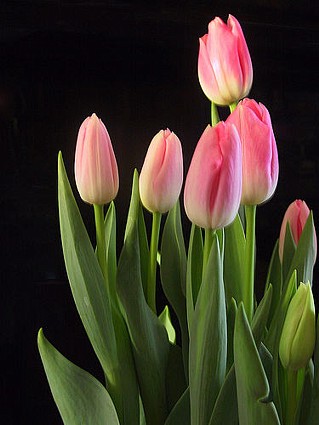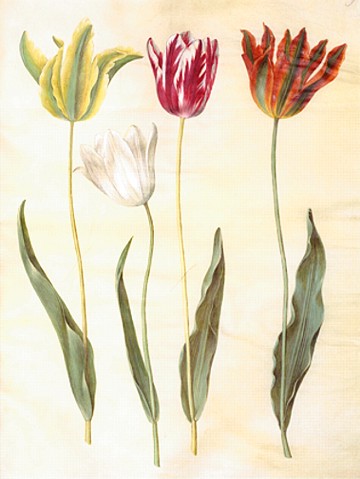Lessico
Tulipa gesneriana
Jacopo
Ligozzi nacque a
Verona nell'anno 1547 e morì a Firenze nell'anno 1626. Formatosi a Verona,
probabilmente da Antonio Badile o Baili (Verona 1518-1560), si trasferì a
Firenze nel 1578 chiamato dal granduca Francesco I![]() . La sua
attività pittorica fu molto intensa. Nell'ambiente del tardo manierismo
fiorentino tentò una sintesi tra i moduli michelangioleschi e un rinnovato
naturalismo e venne influenzato dalla pittura veneta del tardo Cinquecento.
Eseguì anche illustrazioni scientifiche per il naturalista bolognese Ulisse
Aldrovandi. Raggiunse una straordinaria celebrità in tutta Europa per le sue
rappresentazioni di piante e animali.
. La sua
attività pittorica fu molto intensa. Nell'ambiente del tardo manierismo
fiorentino tentò una sintesi tra i moduli michelangioleschi e un rinnovato
naturalismo e venne influenzato dalla pittura veneta del tardo Cinquecento.
Eseguì anche illustrazioni scientifiche per il naturalista bolognese Ulisse
Aldrovandi. Raggiunse una straordinaria celebrità in tutta Europa per le sue
rappresentazioni di piante e animali.


Tulipa gesneriana L. or "Didier's tulip" is a plant belonging to the family of Liliaceae. Synonyms: Tulipa suaveolens (Hayek. non Roth), Tulipa didieri (Jordan). This species has uncertain origins, possibly from Asia and has become naturalised in south-west Europe. Most of the cultivated species, subspecies and cultivars of tulip are derived from Tulipa gesneriana.
Tulip collecting mania swept through Europe and particularly Holland between 1634 and 1637. Bulbs were exchanged for land, livestock, and houses. A single bulb, the Semper Augustus, fetched 6,000 florins in Haarlem, and tulips were routinely traded on stock exchanges throughout Holland. At that time, a florin could purchase a bushel of wheat. As with speculation in any commodity, fortunes were made and lost.
The flower and bulb can cause dermatitis through the allergen tuliposide A, even though the bulbs may be consumed with little ill-effect. The sweet-scented bisexual flowers appear during April and May. Bulbs are extremely resistant to frost, and can tolerate temperatures well below freezing - a period of low temperature is necessary to induce proper growth and flowering, triggered by an increase in sensitivity to the phytohormone auxin. The bulbs may be dried and pulverised and added to cereals or flour.
Tulip (Tulipa spp.), including Tulipa gesneriana, is a widely cultivated plant used as a perennial spring flower in Canada. Many species and hybrids as well as numerous cultivars of tulips may be found in Canada. Tulips contain an allergen, tuliposide A, which causes dermatitis in sensitive individuals. Poisoning of humans and dogs has also been reported when tulip bulbs mistaken for onions were ingested. The allergen tuliposide A is also found in the Peruvian lily (Alstroemeria spp.), and there is cross-sensitivity to onion and garlic (Allium spp). Tulips are not normally a problem to humans, but sensitive individuals should avoid touching the plants (Mitchell and Rook 1979, Cooper and Johnson 1984).

Zeichnung
der Garten-Tulpe (Tulipa gesneriana)
aus dem Gottorfer Codex
von Hans-Simon Holtzbecker - 1649-1659
Die Garten-Tulpe (Tulipa gesneriana) ist eine Pflanzenart aus der Gattung der Tulpen (Tulipa) in der Familie der Liliengewächse (Liliaceae). Diese Art ist eine alte persische Kulturpflanze deren genaue Herkunft unklar ist. Möglicherweise stammt sie von Tulipa armena oder Tulipa schrenkii ab. Die Garten-Tulpe ist eine ausdauernde krautige Pflanze, die Wuchshöhen von 10 bis 70 Zentimeter erreicht. Dieser Geophyt bildet Zwiebeln als Überdauerungsorgane aus. Die Zwiebelhülle ist innen kahl oder hat nur wenige Haare an der Spitze. Die Pflanze bildet keine Ausläufer. Die Laubblätter sind blaugrün und meist nicht wellig. Die Stängelblätter sind oft schmaler als die Blätter vegetativer Pflanzen, welche eine Breite von mehr als 1,5 bis 2 Zentimeter haben. Der Stängel ist (10) 30 bis 70 Zentimeter lang, kahl und selten fein flaumig.
Die Blüten stehen einzeln auf den Stängeln. Sie sind am Grund breit napfig. Die Hüllblätter sind verschieden gefärbt, von rot über violett, schwarzviolett und gelb bis weiß. Viruskranke Pflanzen haben geflammte Blüten. Des Weiteren sind die Blütenhüllblätter abgerundet, ausgerandet, stumpf oder spitz und 4 bis 8,2 Zentimeter lang. Die Staubblätter sind purpur oder gelb. Die Blütezeit liegt im Mai, zum Teil auch schon im April. Die Garten-Tulpe wird verbreitet als Zierpflanze in Rabatten, Sommerrabatten und Staudenbeeten sowie als Schnittblume genutzt.